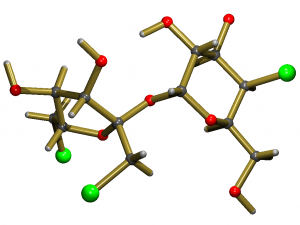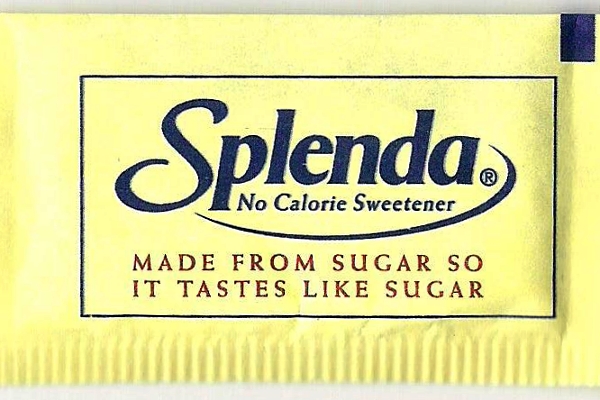by author Sandra Tonn, RHN
 So sucralose is made with sugar, but the finished product is not natural. In fact, the reason it has no calories is because it is not a sugar. Why, then, do many consumers have the impression that it is natural? And does this impression bring with it an assumption of safety? Such questions have spurred a rash of criticism and lawsuits against the makers of sucralose, McNeil Nutritionals.
So sucralose is made with sugar, but the finished product is not natural. In fact, the reason it has no calories is because it is not a sugar. Why, then, do many consumers have the impression that it is natural? And does this impression bring with it an assumption of safety? Such questions have spurred a rash of criticism and lawsuits against the makers of sucralose, McNeil Nutritionals.
Made From Sugar, so It Tastes Like Sugar???
Joe Schwarcz, Director of the McGill University Office for Chemistry and Society in Montreal, is an authority on artificial sweeteners and maintains that sucralose is safe. His only criticism about sucralose is its marketing approach which associates the artificial sweetener with sugar. Schwarcz told the Montreal Gazette that sucralose is different from sugar. Incorporation of three chlorine atoms into the sugar molecule converts it into a totally new substance.??? The Texas Consumer Association, an Austin-based watchdog group, contends that by using the word sugar??? in ads and on packaging, McNeil is trying to link their product with sugar in the minds of consumers to convince them that sucralose is more natural than other sweeteners.
The Centre for Science in the Public Interest (CSPI) commissioned a US Internet survey in April 2004 to find out how consumers perceive Splenda. The survey, which included 426 Splenda users, showed that only eight percent knew the sweetener was made from sugar and chlorine. While 57 percent of Splenda users correctly believed that it was an artificial sweetener, 47 percent of users incorrectly believed Splenda was a natural product.
CSPI Executive Director Michael F. Jacobson, who, with a number of consumer groups, is encouraging an investigation, says, Splendas artificiality may present a marketing challenge, but thats not an excuse to confuse consumers and lead them to believe that Splenda is natural or in any way related to sugar.???
While the CSPI criticizes McNeils advertising campaign, it also considers Splenda to be safe. However, CSPI also says aspartame is probably safe,??? while some consumer-advocate groups consider it decidedly unsafe.
Thus far, three state consumer class action lawsuits and two independent federal suits have been filed citing false advertising and the misleading of consumers. The first to file suit was Merisant Worldwide Inc., the makers of the low-calorie sweetener Equal. The second federal suit was filed by The Sugar Association, a trade organization that represents the US sugar-cane and sugar-beet industries.
Merisants lawsuit states, Splenda is not natural in any sense of the word.??? James Murphy, counsel for The Sugar Association, says, [McNeil Nutritional] is misinforming consumers about the reality of the chlorinate product Splenda.??? Both parties point an accusing finger at McNeils Splenda ad campaign slogan: Made with sugar, so it tastes like sugar.???
Sour Industry War
Lan Lai-Minh, Director of Commun-ications for McNeil Consumer Health-care at the Canadian headquarters in Guelph, Ontario, said in a telephone interview, Nowhere do we say that Splenda is natural.???
It is a fact that Splenda is made from sugar and that it tastes like sugar. Its also a fact that Splenda, which has been on the market since 1991 in Canada, has become the number one sugar substitute. On US shelves since 1998, Splenda has gained more than half of the US market in the last four years. Lai-Minh says the legal action taken against McNeil appears to be in reaction to the success of Splenda.???
Before reaching the courts, the battle began on the Internet with the launch of the Truth about Splenda??? website. The sitewhich is slick, convincing, and features a flavour of fearis promoted as a public education campaign by a group of concerned consumers but is actually headed by The Sugar Association.
McNeil considers the sour attack on their sweetener a smear campaign in an attempt to boost the sale of sugar. In response, they are suing The Sugar Association and other defendants. The lawsuits have not scared off Coca-Cola Co., who will launch a Splenda-sweetened version of Diet Coke this year, making the sweetener even more available and popular.
Dangerously Sweet?
Advertising aside, we know sucralose isnt natural, but is it safe? Apart from the bad-mouthing of its competition, very few people are speaking out against sucralose. Alternative health guru Joseph Mercola provides a convincing account of why to avoid sucralose, including potential problems with thymus glands, liver, kidneys, spleen, growth rate, aborted or extended pregnancy, lowered red blood cell count, increased weight, and diarrhea. However, some of his information is outdated, exaggerated, and poorly supported, which damages his credibility with independent critics. Mercola does accurately point out a key argument in the debate: the long-term safety of sucralose is unknown.
While McNeil tells consumers that the body does not absorb sucralose, the FDAs Final Rule??? report showed that 11 to 27 percent of the compound is absorbed into humans, with the rest being excreted, unchanged, in feces. Dr. Janet Starr Hull (www.janethull.com), author of the book Sweet Poison: How the Worlds Most Popular Artificial Sweetener is Killing Us: My Story (New Horizon Press, 2001), says that chlorocarbons have long been known to cause organ, genetic, and reproductive damage. Hull agrees with Mercola and says shrinkage of the thymus gland in animal studies is a great cause for concern since the thymus gland is a foundation of immunity.
Sweetly Safe?
In 1989 the European Commission Scientific Committee on Food (SCF) stated that sucralose was safe, but had concerns about immunological effects (including an impact on the thymus, spleen, and white-blood-cell counts) and mutagenic activity shown in animal tests. Consideration of new data resulted in a second opinion from the SCF, released in September 2000. The second report stated, There is adequate evidence, both for sucralose and its hydrolysis products, that there are no concerns about mutagenicity, carcinogenicity, [or] developmental or reproductive toxicity.???
The first regulatory body to endorse the safety of sucralose, in 1990, was the Joint Expert Committee on Food Additives (JECFA), which includes the Food and Agriculture Organization of the United Nations (FAO) and the World Health Organization (WHO). In 1991, Canadas Health Protection Branch became the first national regulatory agency to endorse the safety of sucralose, permitting its use in foods and beverages. The US Food and Drug administration (FDA) followed with the broadest initial approval ever given to a food additive and extended the approval in 1999. Today, sucralose is permitted for use in more than 60 countries.
While critics say that sucralose approval was based on only a few tests conducted by the manufacturer, the truth is that sucralose has been tested, in more than 100 studies, for the past 20 years and has an unparalleled safety profile. It is also true, however, that most of those studies were conducted by McNeil Nutritionals and none of them were long-term. Consumers looking to the Canadian Diabetes Association or Dieticians of Canada will not receive any help in determining the truth in this sweetener war. Both organizations simply believe that all sweeteners available in our country go through rigorous testing and therefore must be safe. However, as recent revelations about Vioxx show, rigorous??? has proved to be a relative term when it comes to big business in North America.
Sweet Advice
What do I tell people who ask me, What about Splenda???? In the end I say that safe or not, misleading or not, Splenda is an artificial sweetener. I say, quite simply, that no artificial sweetener is natural and that there is no place for artificial sweeteners in a truly healthy diet. One is either willing to consume artificial foods or not. When we are willing, we must take the health risks that inevitably come with such choices.
The sweetest advice I can give is to stop searching for a way to get away with eating an unhealthy diet. In the long run, artificial sweeteners do not benefit anyone except for those who are concerned with the business of manufacturing and advertising such products.


